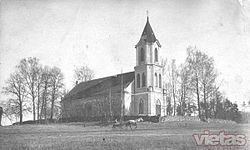 | ||
S lpils
Vecsēlpils ("old Sēlpils", formerly Sēlpils) is a village in Sēlpils parish, Sala municipality, Latvia on the location of the ancient Selonian town of Sēlpils.
Contents
The ruins of the ancient Sēlpils hillfort (lv:Sēlpils pilskalns) were on the left bank of Daugava near Vecsēlpils. Currently, after the construction of Pļaviņas Hydroelectric Power Station and reservoir, the ruins are on an island.
S lpils pakalnos atskan s lijas pavasara rot anas dziesmas
Ancient Sēlpils
Sēlpils or Sēļpils or Selpils (Latin: castrum Selonum, "the castle of the Selonians," German: Selburg) was the military and political center of ancient Selonia, a Baltic land that lay in what is now northern Lithuania and in southern Latvia east of the Semigallian lands and mostly on the left bank of the Daugava river.
Archaeological evidence shows that Sēlpils, 17 km northwest of modern Jēkabpils, was a major settlement between the 10th and 13th centuries. Used as a base for raids by the Selonians and their Lithuanian allies into Latgalian and Livonian lands, Sēlpils was first mentioned in the Chronicle of Henry of Livonia, which describes its capture by the Livonian Order and their Christianized ethnic Livonian allies in 1208. Sēlpils was briefly the seat of a Selonian diocese (1218–1226), and then came under the rule of the Livonian Order, which constructed fortifications there for the Advocate (German: Vogt) of the Order. These were destroyed by the Swedes in 1704, during the Great Northern War, and only traces of the foundations are visible at the site today.
The importance of Sēlpils as a trading center on the Daugava declined after the military devastation of the early 18th century.
